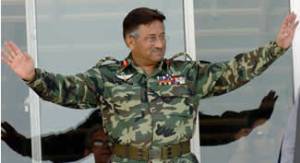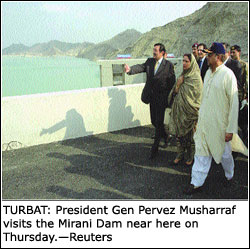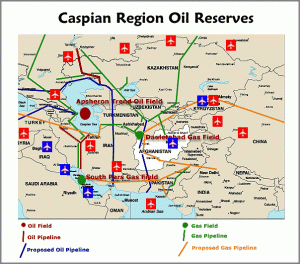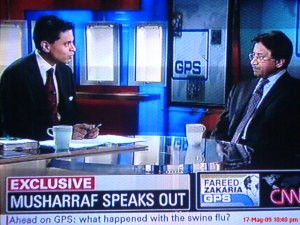Compiled By: Mirza Rohail B
©Our leader – Musharraf
All this is all the more amazing when one considers that just six years ago, Pakistan was on the verge of bankruptcy, with only a little more than $1bn in foreign exchange reserves and its stock market teetering at 1,000 points (worth $5 billion only) and foreign debt servicing at 65% of GDP. Our exports were at a pitiful $7.5 billion.
The once ever-declining rupee stood stable at around 60-61 to a dollar since Musharraf took over. Of the 184 member countries of the IMF, Pakistan’s rate of economic growth 7% is one of the best in the world. The Karachi stock market is now above 13,000 points and worth around $65 billion. Now foreign debt servicing has lowered to become 28%. Our exports increased to become $18 billion.
1. Pakistan economy is among the fastest growing economies in the world as its economy has reached the size of $170 billion from a mere $70 billion in 1999. Pakistan attracted a record FDI of $8.4 billion in 2007.
2. 2007: National revenues had swelled from Rs 308 billion during 1988-99 to around Rs 800bn in 2008; and Federal Board of Revenue estimates now 2.8 million Income Tax payers.
Year Total CBR Direct Indirect Custom Sales Central excise
1998-99 308.5bn 110.4bn 198.1bn 65.3bn 72bn 60.8bn
2005-06 712.5bn 224.6bn 487.9bn 138.2bn 294.6bn 55bn
2008-09 810.3bn 305bn – 105.3bn 319.3bn 80.5bn (2008-09 Progressive)
3. Public sector development program (PSDP) has also grown from Rs 80 billion in 1999; to Rs 520 billion in 2007 and increased further to Rs 549.7 billion in 2008.
4. FACT: The rate of growth in Pakistan Large Scale Manufacturing (LSM) is at a 30-year high. Construction activity is at a 17-year high.
LSM: 1999-00 was 1.5%, and 2004-05 was 19.9%, and 2006-07 was 8.6% and 2007-8 is 5%.
5. FACT: The Infrastructure Industries Index, which measures the performance of Seven industries, i.e. Electricity generation, Natural gas, Crude oil, Petroleum products, Basic metal, Cement and coal, has recorded a 26.2 percent growth in Industrial sector of Pakistan.
6. FACT: Jan 14: Pakistan now has a total of 245,682 Educational institutions in all categories, including 164,579 (i.e. 67 per cent) in the public sector and 81,103 (i.e. 100 per cent) in the private sector, reports the National Education Census (NEC-2005). The census — jointly conducted by the Ministry of Education, the Academy of Educational Planning and Management (AEPAM) and the Federal Bureau of Statistics (FBS) — reveals that the number of private-sector institutions has increased from 36,096 in 1999-2000 to 81,103 in 2005, i.e. by 100 per cent. 45,007 Educational Institutions have increased in Musharraf Era.
7. FACT: Pakistan is 3rd in world in Banking profitability, a report of IMF said. On the IMF chart, in late 2006, Pakistan’s banking profitability is on third position after Colombia and Venezuela. On the IMF chart, India is on 36th position and China is on 40th position. Pakistan’s Banking sector turned profitable in 2002. Their profits continued to rise for the next five years and peaked to Rs 84.1 ($1.1 billion) billion in 2006. Pakistan’s Financial Services
8. 11 May 2009: By producing 7.746 tonnes of gold during the last five years – 2004 to 2008 – Pakistan has joined the ranks of gold producing countries. According to the data with the Saindak Metal Limited – during the last five years – Pakistan has produced 86,013 tonnes of copper, 7.746 tonne gold and 11.046 tonne silver, besides the production of 14,482 tonnes of magnetite concentrate (iron), bringing in a total of $633.573 million.
9. In 1999, what we earned as GDP: we used to give away 64.1 % as foreign debt and liabilities. Now in 2006, what we earn as GDP: we give ONLY 28.3 % as foreign debt and liabilities. Now we are SAVING 35 % of Our GDP for economic growth.
External debt & liabilities (EDL):
1988 – $ 18 billion
1990 – $ 20 billion
1999 – $ 39 billion
2007 – $ 40.17 billion
2008 – $ 45 billion
10. According to Economic Survey 2005. Poverty in Pakistan in 2001 was 34.46%. And, now after 7 years of Musharraf; Poverty in 2005 was 23.9%. Poverty DECREASED by 10.56%. Overall, 12 million people have been pushed out of Poverty in 2001 -2005!
11. Literacy rate in Pakistan has increased from 45% (in 2002) to 53% (in 2005). And, Education now receives 4% of GDP and English has been introduced as compulsory subject from grade 1.
12. 12-4-07: The IT industry, which was virtually non-existent seven years ago, has grown to be worth $2 billion of which $1 billion is export related. It registered a 50% growth. 55 foreign IT companies have already entered the market. Now the sector employed 90,000 professionals.
Continue Reading »








 Written By:
Written By:
 Yahya Khan in the 1960’s, our governments failed to conceive and initiate major electricity projects.
Yahya Khan in the 1960’s, our governments failed to conceive and initiate major electricity projects.
